Questions with Answers, Solution | Geometry | Term 1 Chapter 4 | 6th Maths - Exercise 4.4 | 6th Maths : Term 1 Unit 4 : Geometry
Chapter: 6th Maths : Term 1 Unit 4 : Geometry
Exercise 4.4
Exercise
4.4
Miscellaneous
Practice Problems
1.
Find the type of lines marked in thick lines (Parallel, intersecting or perpendicular).
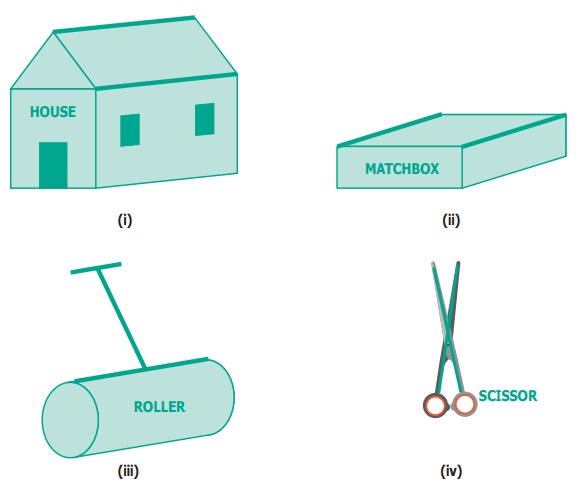
Answer: (i) Parallel lines
(ii) Parallel lines
(iii) Parallel & Perpendicular lines
(iv) Intersecting lines.
2.
Find the parallel and intersecting line segments in the picture given below.
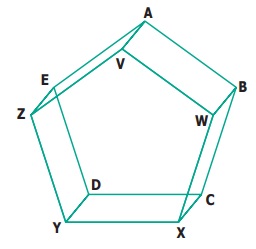
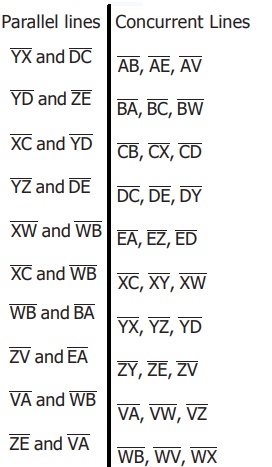
3.
Name the following angles as shown in the figure.
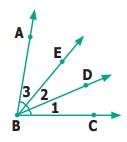
(i)
∠1 =
(ii)
∠2 =
(iii)
∠3 =
(iv)
∠1 + ∠2 =
(v)
∠2 + ∠3 =
(vi) ∠1 + ∠2 + ∠3 =
Answer:
(i) ∠1 = ∠CBD (or) ∠DBC
(ii) ∠2 = ∠DBE (or) ∠EBD
(iii) ∠3 = ∠EBA (or) ∠ABE
(iv) ∠1 + ∠2 = ∠CBE (or) ∠EBC
(v) ∠2 + ∠3 = ∠DBA (or) ∠ABD
(vi) ∠1 + ∠2 + ∠3 = ∠ABC (or) ∠CBA
4.
Measure the angles of the given figures using protractor and identify the type of
angle as acute, obtuse, right or straight.

Answer:
(i) Right angle
(ii) Acute angle
(ii) Straight line
(iv) Obtuse angle
5.
Draw the following angles using the protractor.
(i)
45º
(ii)
120º
(iii)
65º
(iv)
135º
(v)
0º
(vi)
180º
(vii)
38º
(viii) 90º

6.
From the figures given below, classify the following pairs of angles into complementary
and non complementary.
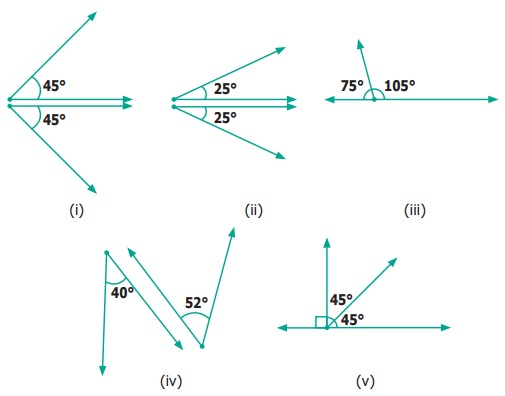
Answer:
Complementary – ( i) &
(v)
Non−complementary − (ii), (iii)
& (iv)
7.
From the figures given below, classify the following pairs of angles into supplementary
and non supplementary.
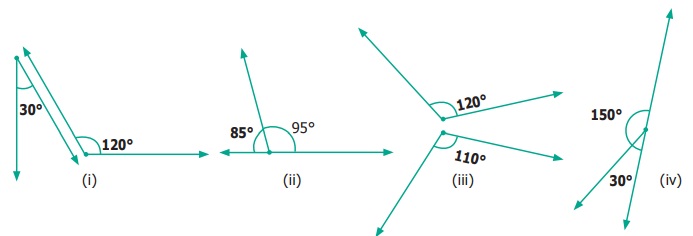
Answer:
Supplementary
− (ii) & (iv)
Non−Supplementary − (i),
(iii)
8.
From the figure
(i)
name a pair of complementary angles
(ii)
name a pair of supplementary angles
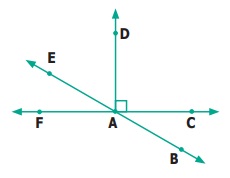
Answer:
(i) Complementary angles
∠FAE
& ∠EAD
(ii) Supplementary angles
(a) ∠FAD & ∠DAC
(b) ∠BAF & ∠FAE
(c) ∠EAD & ∠DAB
(d) ∠BAC & ∠CAE
9.
Find the complementary angle of
(i)
30º
(ii)
26º
iii)
85º
(iv)
0º
(v)
90º
Solution:
Complementary angle (90°− θ)
(i) 90° − 30° = 60°
(ii) 90° − 35° = 65°
(iii) 90° − 85° = 5°
(iv) 90° − 0° = 90°
(v) 90° − 90° = 0°
10.
Find the supplementary angle of
(i)
70º
(ii)
35º
(iii)
165º
(iv)
90º
(v)
0º
(vi)
180º
(vii)
95º
Solution:
Supplementary angle (180° − θ°)
(i) 180° − 70° = 110°
(ii) 180° − 35° = 145°
(iii) 180° − 165° = 15°
(iv) 180° − 90° = 90°
(v) 180°− 0° = 180°
(vi) 180° − 180° = 0°
(vii) 180° − 95° = 85°
Challenging
Problems
11.
Think and write an object having
● Parallel
lines (1) __________ (2) __________ (3) __________
● Perpendicular
lines (1) __________ (2) __________ (3) __________
● Intersecting
lines (1) __________ (2) __________ (3) __________
• Parallel lines
Answer: (1) Railway Track (2)
edgesof scale (3) Legs of table
• Perpendicular lines
Answer:
(1) Cross bars of windows
(2) Adjacent sides of the text book
(3) Adjacent sides of Black board
• Intersecting lines
Answer: (1) Ladder (2) Blades of
scissor (3) Cross bars of windows
12.
Which angle is equal to twice its complement?
Answer: 60°
13.
Which angle is equal to two-third of its supplement?
Answer: 72°
14.
Given two angles are supplementary and one angle is 20º more than other. Find the
two angles.
Answer: The two angles are 80° & 100°
15.
Two complementary angles are in ratio 7:2. Find the angles.
Answer: Two angles are 70° & 20°
16.
Two supplementary angles are in ratio 5:4. Find the angles.
Answer: The angles are 100° & 80°
Answers:
Exercise 4.4
1) i) Parallel lines
ii) Parallel lines
iii) Parallel and Perpendicular lines
iv) Intersecting lines
2) Parallel lines

3) i) ∠1
= ∠CBD
or ∠DBC
ii) ∠2
= ∠DBE
or ∠EBD
iii) ∠3
= ∠ABE
or ∠EBA
iv) ∠1+∠2
= ∠CBE
or ∠EBC
v) ∠2
+ ∠3
= ∠ABD
or ∠DBA
vi) ∠1
+ ∠2
+ ∠3
= ∠ABC
or ∠CBA
4) i) right angle ii) acute angle iii) straight angle iv) obtuse
angle
6) (i) and (v) are complementary angles (ii), iii) and iv) are
non-complementary angles
7) ii) and iv) are supplementary
i) and iii) are not
supplementary
8) i) ∠
FAE; ∠EAD
ii) ∠FAD;
∠DAC
∠BAC;
∠CAE
∠
FAB; ∠BAC
∠
FAB; ∠FAE
9) i) 60˚ ii) 64˚ iii) 5˚ iv) 90˚ v) 0˚
10) i) 110˚ ii) 145˚ iii) 15˚ iv) 90˚ v) 180˚ vi) 0˚ vii) 85˚
11) i) Legs of the table, railway track, edges of the scale
ii) Adjacent sides of a Board, Cross bars of windows, Adjacent
sides of the textbook
iii) Cross bars of windows, Ladder, blades of a scissor.
12) 60˚ is twice its complement.
13) 72˚
14) The two angles are 80˚ and 100˚
15) Two angles are 70˚ and 20˚.
16) The angles are 100˚ and 80˚.
EUCLID
(325 BC – 265 BC)

He was a Greek Mathematician who founded
the plane geomety through his postulates in a set of 13 books called "ELEMENTS". His work “ELEMENTS” influenced the
whole world’s understanding of geometry for generations.
Related Topics